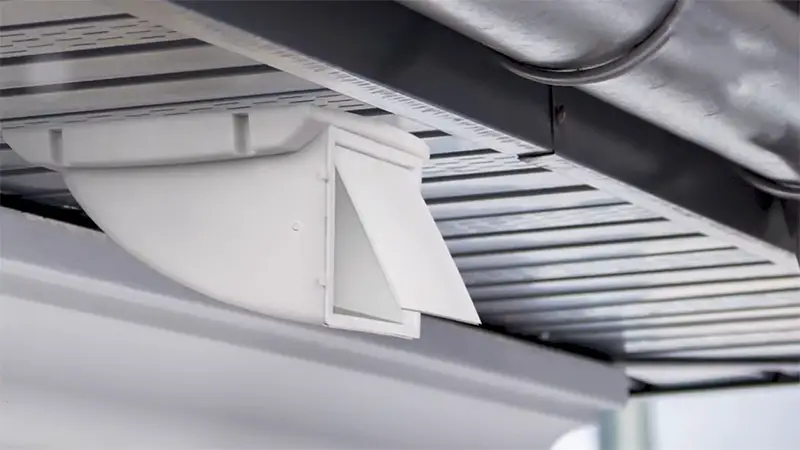If you’re renovating your kitchen or installing a new range hood, you might wonder about the best way to vent it. While many people choose to vent their range hood through the roof, another option is to vent it through the soffit.
This can be an attractive option if you don’t want to cut a hole in your roof or your range is on an exterior wall.
However, before you decide, it’s essential to consider the pros and cons of venting your range hood through the soffit. An effective range hood removes smoke, fumes, moisture, and odors from the kitchen.
The air duct of the range hood can instead be diverted through an overhanging soffit on the side of the house if the homeowner wants to avoid going through the roof.
It is not a good idea to install vent terminations from bathroom or kitchen exhaust fans in soffits, for a number of reasons. Typically, warm moist air rises through the soffit, which is a problem.
To prevent moisture from rising back into the attic, you should not vent into or even under the soffits unless you are more than one foot below the soffit.
In this article, we’ll dive into everything you need to know about this alternative venting method, so you can make an informed choice for your kitchen.
Is Venting Through a Soffit OK?
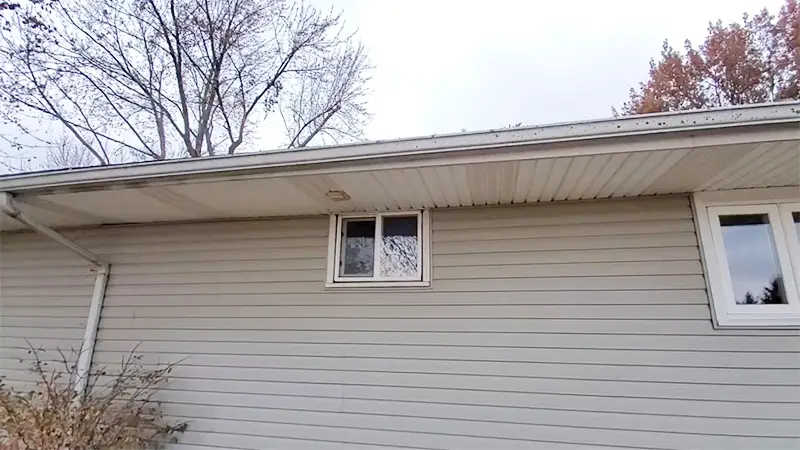
The soffit could be a more reasonable choice if you’re uncomfortably venting directly through the roof for your range hood exhaust. However, you must follow a few rules.
If you follow the International Residential Code and follow the rules for venting through the soffit, it is possible to vent through the soffit. In what follows, we explain why these rules exist and why they are justified.
Venting the exhaust from the range hood through the soffit is perfectly permissible under Section M1503.3 of the IRC.
A smooth inner surface, airtight seal, independence from other exhaust systems, and backdraft damper are necessary for such a duct to work.
As a result of these specifications, wind, other exhaust systems, and the quality of the duct are limited in how much interference they cause. While venting through the soffit is permitted, venting into the soffit is expressly prohibited.
In addition, you should not vent into the soffits or under the soffits unless you are more than a foot and a half below the soffit. This will allow the wind to disperse moisture before returning to the attic.
Venting into the soffit rather than through it lets most of the exhaust stay inside your attic, causing potential health issues and heat damage.
Benefits of Venting Range Hoods Through Soffits
Soffit venting can provide several benefits, such as:
Less Weather Interference
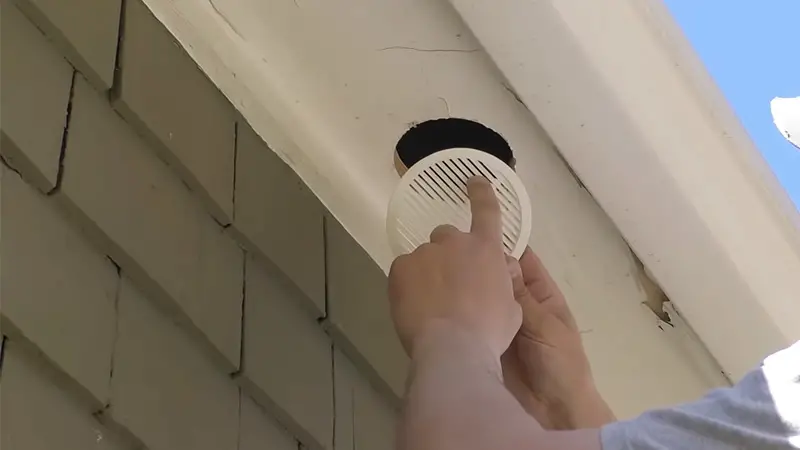
Because the soffit is located under the eaves of your roof, it has minimal impact from the weather.
Since the range hood opening is exposed to the elements, rain or snow can pass the backdraft damper when venting through the roof.
It is also possible for snow or rain to leak into the attic around the vents.
The ducts of your range hood can be infiltrated by wind, even with a backdraft damper, creating cold drafts and noise.
This may reduce the efficiency of the exhaust system since the flow of wind inward would counteract the outward flow of exhaust gas.
A soffit ventilation system will drastically reduce the likelihood of rain and snow getting into the duct, as well as wind infiltrating the duct.
No Holes Cut in the Roof
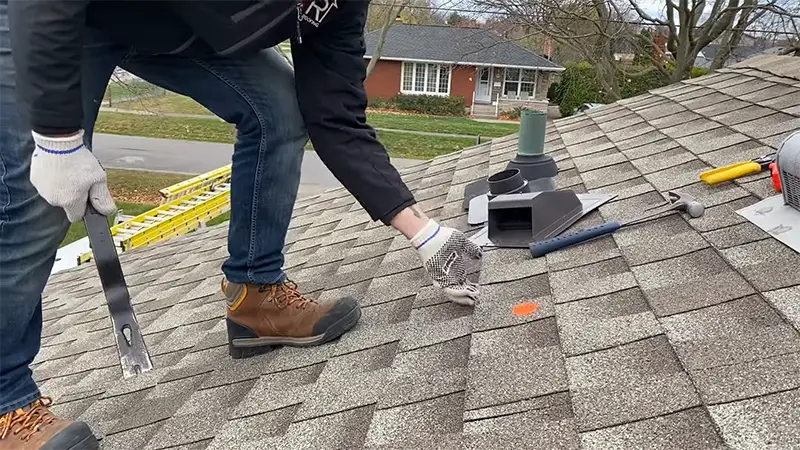
In range hoods, ventilation can be provided through the roof. However, the disadvantage is having to cut a hole in your roof to accomplish this.
The roofing material is challenging to cut through, and if you are unable to do so, you may harm its integrity. It could result in water leaking from the range hood.
Below the eaves, the soffit is sheltered and easier to cut into.
Can Be the Shortest Route
Despite some challenges, it can be less challenging than following the IRC to vent the range hood exhaust through the soffit.
Shorter vent routes are very energy-efficient and can reduce energy consumption.
Drawbacks of Venting Range Hoods Through Soffits
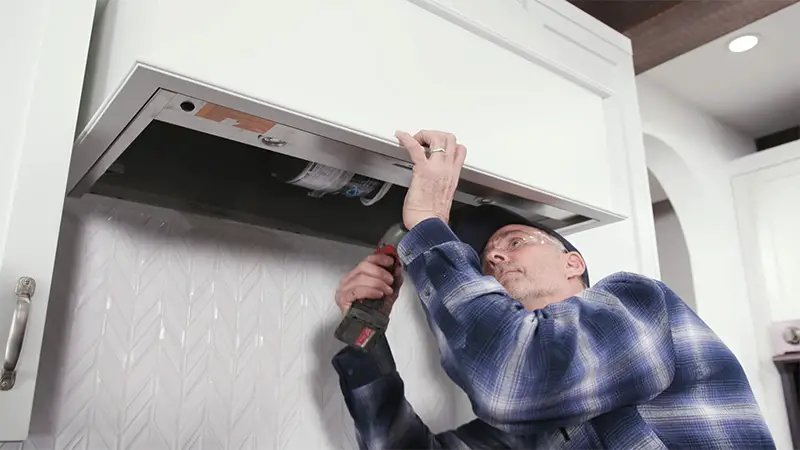
Although venting a range hood through the soffit can be convenient and cost-effective, there are some drawbacks to be aware of.
Downward Venting is Less Efficient
When you vent through the soffit, your air is vented downward, unlike when you vent through the roof, where the heated air naturally rises.
Since the oven heat and heat byproducts from other kitchen appliances will be trapped, the exhaust from your kitchen will most likely be warm.
The reduced flow downwards introduced by this hot kitchen exhaust system will reduce the system’s efficiency.
Exhausted Air Can Gather
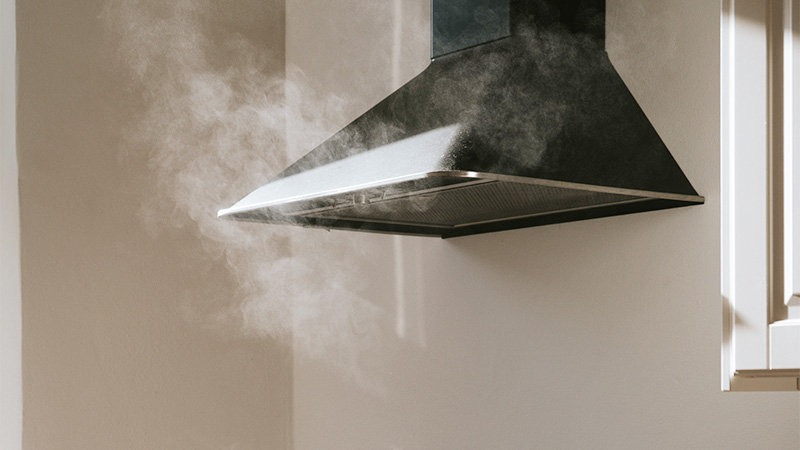
The wind can also keep exhausted air under the eaves since it pushes it towards the roof rather than letting it naturally disperse.
As a result of the heat coming off the exhaust, it naturally rises and gathers under the eaves, making it harder for it to escape into the atmosphere. Because of the moisture it contains, this gathered air can damage your home.
Having a vented soffit in your attic allows exhaust gases to enter your attic, thereby decreasing the air quality in your home and possibly contaminating other parts of the home (though installing the range hood exhaust near an attic vent is not allowed).
Specific Wind Directions Can Cause Issues
Even though most of the soffit is protected against the elements, there are some angles where the wind can make its way past the vents.
A backdraft damper prevents wind infiltration most of the time. Even so, wind can still reduce the efficiency of the exhaust system because it forces the air to attempt to escape the vents against the wind.
Other Vent Location Considerations
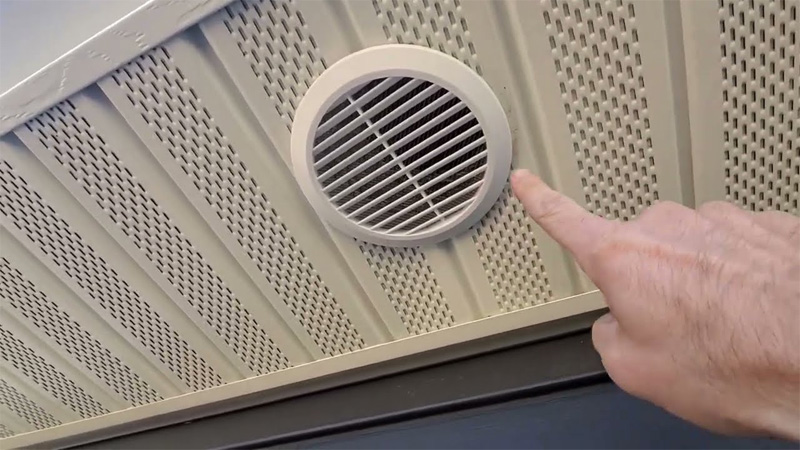
In addition to considering the location of the vent, there are other factors to consider.
Distance from Mechanical Air Intakes
If the range hood exhaust termination is not at least 3 feet above the mechanical air intake, the IRC dictates that it must be 10 feet away.
As a result of this specification, range hood exhaust exiting at least 3 feet or higher above a mechanical air intake is unlikely to be recirculated.
This is large because a range hood exhaust will naturally rise rather than sink toward the mechanical air intake.
As a result of mechanical air intakes actively bringing air in, the 10-foot regulation is in place. It’s important for air quality and comfort reasons that there is a larger space between the intake and exhaust opening.
Distance from Non-Mechanical Air Intakes
The range hood exhaust openings must also be at least three feet away from non-mechanical air intakes, as made by the property line rules. There are also windows, doors, and gravity air intakes.
Due to this possibility, range hood exhaust could be recirculated into the home through these openings.
Taking smoke out of the kitchen with a range hood exhaust that terminates near an opening in your house can cause it to come straight back into the house.
This substance can also cause respiratory and eye irritation and activate smoke alarms.
Since soffit vents often sit above windows, soffit venting may not be the best choice for meeting this requirement.
Distance from Property Lines
Following Section M1504.3 of the IRC, your range hood exhaust system opening must be at least 3 feet from property lines to the vent.
Located under your eaves, under your soffit, your home’s soffit may be closer to the property line than your walls if your house is close to one or more sides of the line.
In this scenario, you wouldn’t be permitted to install soffit vents closer than 3 feet to the property line. Range hood exhaust may enter your neighbor’s property if your soffit vents are close to a property line.
You might encounter higher temperatures, smoke, and other dangerous substances if your neighbor has a patio, window, door, or air intake near this property line.
Why the Shortest Ducting Route is Best
The fact remains that no matter what duct material is chosen for a range hood, the more distance the exhaust has to travel, the less efficient the process will be.
Range hood exhaust loses speed as it travels farther away from the fan as it travels farther from the range hood. The process becomes less efficient as the exhaust slows down.
It is also necessary to purchase more ducting material if the route is more extended. Ducting material contains a high risk of a leak, so the more there is, the more likely there will be a leak.
All things considered, the shorter the ducting route, the better, and sometimes venting through the soffit is the simplest.
Why Range Hoods Have to Terminate Outside
No matter why the range hood is on, especially in the kitchen, an exhaust system is crucial, whether it is used to decrease heat, eliminate smoke, or something else.
In addition to heat and smoke, numerous other ingredients can cause health problems when cooking without a range hood. For example, carbon dioxide, carbon monoxide, and formaldehyde are harmful substances.
As occupants, we are exposed to these chemicals that can cause headaches, nausea, skin irritation, and more.
A range hood that terminates in the attic could still carry these harmful substances inside the living space, where occupants may become sick from exposure.
Having range hood exhaust in the home is uncomfortable because of its temperature and smell.
Final Words
Soffit vents tend to vent moist, warm air, which is problematic because it wants to rise. In effect, your venting pushes air “down” at the soffit, thus negating the chimney effect.
This air also escapes from the vent and goes straight into the soffit. The ventilation in the attic is undoubtedly better than the ventilation in the roof.
There is no better place to sit than on the roof. Neither snow nor ice should be a concern. The practice is common here in the United States. Then stick it a couple of feet up and put on a hat.

